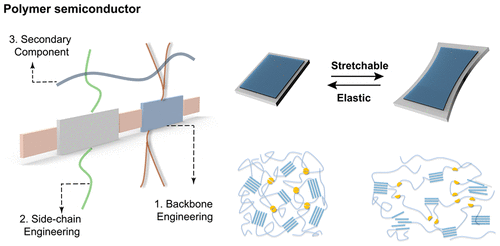当前位置:
X-MOL 学术
›
J. Am. Chem. Soc.
›
论文详情
Our official English website, www.x-mol.net, welcomes your
feedback! (Note: you will need to create a separate account there.)
Molecular Design of Stretchable Polymer Semiconductors: Current Progress and Future Directions
Journal of the American Chemical Society ( IF 14.4 ) Pub Date : 2022-03-09 , DOI: 10.1021/jacs.2c00072
Yu Zheng 1, 2 , Song Zhang 1 , Jeffrey B-H Tok 1 , Zhenan Bao 1
Journal of the American Chemical Society ( IF 14.4 ) Pub Date : 2022-03-09 , DOI: 10.1021/jacs.2c00072
Yu Zheng 1, 2 , Song Zhang 1 , Jeffrey B-H Tok 1 , Zhenan Bao 1
Affiliation

|
Stretchable polymer semiconductors have advanced rapidly in the past decade as materials required to realize conformable and soft skin-like electronics become available. Through rational molecular-level design, stretchable polymer semiconductor films are now able to retain their electrical functionalities even when subjected to repeated mechanical deformations. Furthermore, their charge-carrier mobilities are on par with the best flexible polymer semiconductors, with some even exceeding that of amorphous silicon. The key advancements are molecular-design concepts that allow multiple strain energy-dissipation mechanisms, while maintaining efficient charge-transport pathways over multiple length scales. In this perspective article, we review recent approaches to confer stretchability to polymer semiconductors while maintaining high charge carrier mobilities, with emphasis on the control of both polymer-chain dynamics and thin-film morphology. Additionally, we present molecular design considerations toward intrinsically elastic semiconductors that are needed for reliable device operation under reversible and repeated deformation. A general approach involving inducing polymer semiconductor nanoconfinement allows for incorporation of several other desired functionalities, such as biodegradability, self-healing, and photopatternability, while enhancing the charge transport. Lastly, we point out future directions, including advancing the fundamental understanding of morphology evolution and its correlation with the change of charge transport under strain, and needs for strain-resilient polymer semiconductors with high mobility retention.
中文翻译:

可拉伸聚合物半导体的分子设计:当前进展和未来方向
随着实现顺应性和柔软的皮肤状电子产品所需的材料变得可用,可拉伸聚合物半导体在过去十年中迅速发展。通过合理的分子级设计,可拉伸聚合物半导体薄膜现在即使在受到重复机械变形的情况下也能够保持其电气功能。此外,它们的载流子迁移率与最好的柔性聚合物半导体相当,有些甚至超过了非晶硅。关键的进步是分子设计概念,它允许多种应变能量耗散机制,同时在多个长度尺度上保持有效的电荷传输路径。在这篇观点文章中,我们回顾了最近在保持高电荷载流子迁移率的同时赋予聚合物半导体可拉伸性的方法,重点是控制聚合物链动力学和薄膜形态。此外,我们提出了对固有弹性半导体的分子设计考虑,这些是在可逆和重复变形下可靠设备操作所需的。涉及诱导聚合物半导体纳米限制的一般方法允许结合其他几种所需的功能,例如生物降解性、自愈性和光图案化能力,同时增强电荷传输。最后,我们指出了未来的方向,包括推进对形态演化的基本理解及其与应变下电荷传输变化的相关性,
更新日期:2022-03-09
中文翻译:

可拉伸聚合物半导体的分子设计:当前进展和未来方向
随着实现顺应性和柔软的皮肤状电子产品所需的材料变得可用,可拉伸聚合物半导体在过去十年中迅速发展。通过合理的分子级设计,可拉伸聚合物半导体薄膜现在即使在受到重复机械变形的情况下也能够保持其电气功能。此外,它们的载流子迁移率与最好的柔性聚合物半导体相当,有些甚至超过了非晶硅。关键的进步是分子设计概念,它允许多种应变能量耗散机制,同时在多个长度尺度上保持有效的电荷传输路径。在这篇观点文章中,我们回顾了最近在保持高电荷载流子迁移率的同时赋予聚合物半导体可拉伸性的方法,重点是控制聚合物链动力学和薄膜形态。此外,我们提出了对固有弹性半导体的分子设计考虑,这些是在可逆和重复变形下可靠设备操作所需的。涉及诱导聚合物半导体纳米限制的一般方法允许结合其他几种所需的功能,例如生物降解性、自愈性和光图案化能力,同时增强电荷传输。最后,我们指出了未来的方向,包括推进对形态演化的基本理解及其与应变下电荷传输变化的相关性,




































 京公网安备 11010802027423号
京公网安备 11010802027423号